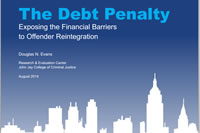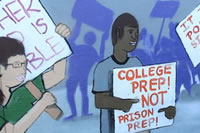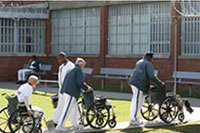 How are prison bankers, private vendors, and corrections agencies profiting within an industry plagued by debt? By charging the families of those incarcerated for everything from phone calls to restitution and fees to goods and services they need while behind bars. Prisoners who have jobs on the inside make extremely low wages, and those with families on the outside who can help often receive funds from an internet service called JPay, the undisputed leader in the market for getting money into prisons.
How are prison bankers, private vendors, and corrections agencies profiting within an industry plagued by debt? By charging the families of those incarcerated for everything from phone calls to restitution and fees to goods and services they need while behind bars. Prisoners who have jobs on the inside make extremely low wages, and those with families on the outside who can help often receive funds from an internet service called JPay, the undisputed leader in the market for getting money into prisons.
With families sending almost a billion dollars to loved ones behind bars through JPay in the past year alone, the company easily collected millions of dollars in fees. In many states, families do not have a choice when using the services, as JPay has become responsible for handling not only electronic payments in prisons, but the traditional money order services as well.
Is this new method of caring for incarcerated loved ones fair to families already in crisis? Watch the full video at publicintegrity.org![]()

 In a new paper released in August, Douglas N. Evans of John Jay College of Criminal Justice’s Research & Evaluation Center discusses the seemingly endless cycle of crime, fees and debt associated with our current penal system. Across the country, convicts are required to pay varying sums of money to courts and victims in the form of court fees, installment fees, late fees, and restitution, which can become a large burden for offenders who have poor chances of finding employment upon release.
In a new paper released in August, Douglas N. Evans of John Jay College of Criminal Justice’s Research & Evaluation Center discusses the seemingly endless cycle of crime, fees and debt associated with our current penal system. Across the country, convicts are required to pay varying sums of money to courts and victims in the form of court fees, installment fees, late fees, and restitution, which can become a large burden for offenders who have poor chances of finding employment upon release. Out of 42,000 children who attend court schools in California as part of the state’s juvenile corrections system, only about 20% re-register at other schools upon their release. A juvenile record combined with the lack of a high school education is a recipe for disaster, and helps fuel California’s large adult prison population.
Out of 42,000 children who attend court schools in California as part of the state’s juvenile corrections system, only about 20% re-register at other schools upon their release. A juvenile record combined with the lack of a high school education is a recipe for disaster, and helps fuel California’s large adult prison population. The Juvenile Justice and Delinquency Prevention Act, a 40 year old landmark federal mandate aimed at helping one of our nation’s most vulnerable populations, is supposed to be reauthorized every five years. Unfortunately, the last reauthorization by Congress was back in 2002. In addition, it has been almost 20 years since substantial amendments were added to the legislation, no doubt leaving gaps in services for at-risk youth.
The Juvenile Justice and Delinquency Prevention Act, a 40 year old landmark federal mandate aimed at helping one of our nation’s most vulnerable populations, is supposed to be reauthorized every five years. Unfortunately, the last reauthorization by Congress was back in 2002. In addition, it has been almost 20 years since substantial amendments were added to the legislation, no doubt leaving gaps in services for at-risk youth. The past four decades have brought about the most sustained and widespread imprisonment in human history. The United States represents 5% of the world’s population, yet it is responsible for 25% of the world’s incarcerated population. With 2.3 million inmates, the U.S. beats all other countries in terms of the overall prison population and incarceration rates per capita.
The past four decades have brought about the most sustained and widespread imprisonment in human history. The United States represents 5% of the world’s population, yet it is responsible for 25% of the world’s incarcerated population. With 2.3 million inmates, the U.S. beats all other countries in terms of the overall prison population and incarceration rates per capita. A recently completed three year review of federal inmate suicides in Canada show that nearly half occurred in segregation cells – which are supposed to be under close supervision – prompting the chief correctional investigator Howard Sapers, to raise questions about the treatment of mentally ill inmates in the system.
A recently completed three year review of federal inmate suicides in Canada show that nearly half occurred in segregation cells – which are supposed to be under close supervision – prompting the chief correctional investigator Howard Sapers, to raise questions about the treatment of mentally ill inmates in the system. In southwestern Illinois, the juvenile court system is looking to make good on the concept of “a jury of one’s peers” with a new teen court model. Any teen without a serious offense (or no non-violent offenses in the last six months) is eligible to sign up to become a teen juror, with a training to be held in mid-October.
In southwestern Illinois, the juvenile court system is looking to make good on the concept of “a jury of one’s peers” with a new teen court model. Any teen without a serious offense (or no non-violent offenses in the last six months) is eligible to sign up to become a teen juror, with a training to be held in mid-October. On August 30th, the <a href="http://www
On August 30th, the <a href="http://www  In this new report from the Brennan Center for Justice at NYU School of Law, researchers looked at one very specific piece of the criminal justice puzzle – federal prosecutors. These men and women have significant power within the system; they decide which cases to bring to trial and also make sentencing recommendations.
In this new report from the Brennan Center for Justice at NYU School of Law, researchers looked at one very specific piece of the criminal justice puzzle – federal prosecutors. These men and women have significant power within the system; they decide which cases to bring to trial and also make sentencing recommendations. Wyoming’s prisons currently have the second best recidivism rate in the US. In Wyoming out of a hundred released prisoners, only twenty five return to prison – compared with forty nationally – an achievement the Wyoming Department of Corrections attributes to its education programs. According to inmates, prison education provides a silver lining during incarceration, and a RAND corporation report finds that it also saves taxpayer’s money.
Wyoming’s prisons currently have the second best recidivism rate in the US. In Wyoming out of a hundred released prisoners, only twenty five return to prison – compared with forty nationally – an achievement the Wyoming Department of Corrections attributes to its education programs. According to inmates, prison education provides a silver lining during incarceration, and a RAND corporation report finds that it also saves taxpayer’s money.